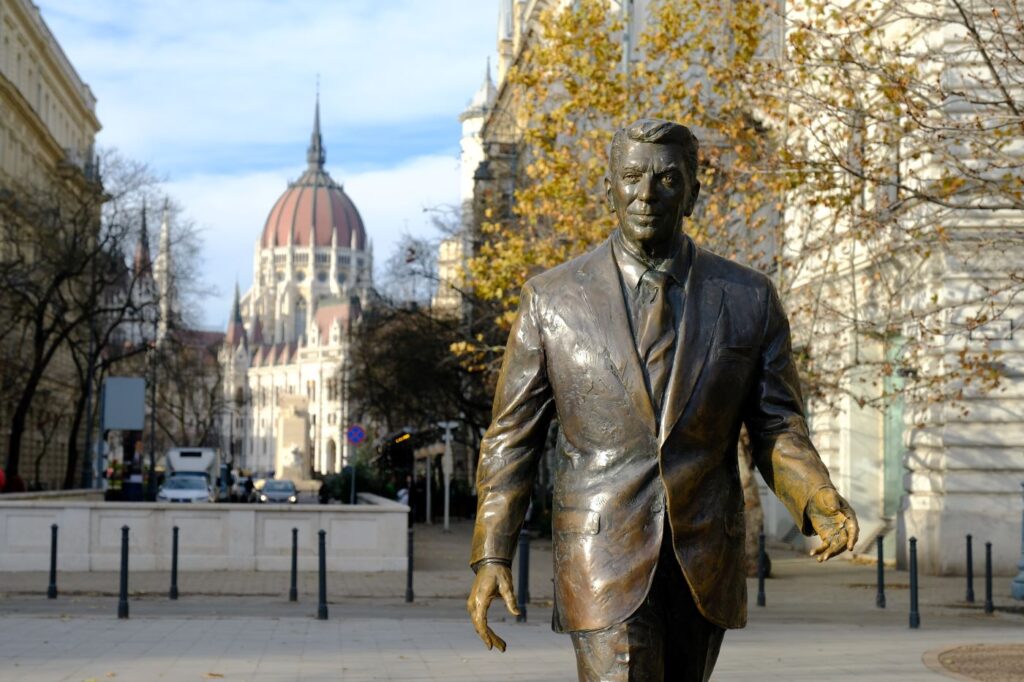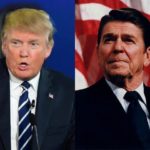I have heard it said that all biography is, in an important sense, autobiography. A biographer cannot be purely objective when researching the life of a fellow human being, because biographers, like their subjects, are human. They have values, beliefs, backgrounds, habits, families, and other unique features that shape their worldviews, just as their subjects did. Thus, all biographers are influenced in significant ways by their backgrounds and familiarities.
But how much more challenging is it for the biographer or historian to consider a subject who lived within his own lifespan and memory? In The Peacemaker, William Inboden has produced a presidential biography (albeit not a full “life”) of Ronald Reagan, whose two terms from 1981 to 1989 spanned Inboden’s formative years as a young teenager (Inboden was born in 1973). The biographer is faced with a distinctive challenge when he has direct reminiscence of the subject—especially when those reminiscences are rooted in adolescent years, when opinions independent of one’s parents begin to form. The 1980s were actually not that long ago! Writing history and biography from the recent past has all the challenges of presenting that past for present audiences. But it has an added challenge: a lack of perspective that bygone eras provide. The recent past doesn’t have the clarity that more distant eras do, such as the lives of George Washington and George Washington Carver.
The lack of perspective on Reagan’s life is evidenced by the fact that his legacy is still fraught with controversy today, as the wide range of historical literature shows. Sympathetic biographies, such as Steven F. Hayward’s two-volume The Age of Reagan (2001, 2009), H. W. Brands’s 2015 Reagan: The Life, David T. Byrne’s 2018 Ronald Reagan: An Intellectual Biography, and Jacob Weisberg’s 2016 contribution to the American Presidents series all seek to correct the caricatures of Reagan as a simpleton or a warmonger. On the other hand, Rick Perlstein’s The Invisible Bridge: The Fall of Nixon and the Rise of Reagan (2015) and Reaganland: America’s Right Turn, 1976–1980 (2021), and Haynes Johnson’s Sleepwalking Through History: America in the Reagan Years (1991) are examples of thoroughly negative treatments of Reagan. And there are works that complicate the Reagan legacy, demonstrating a mixed record of success and failure, such as Sean Wilentz’s 2008 The Age of Reagan: A History, 1974–2008 and Gil Troy’s 2007 Morning in America: How Ronald Reagan Invented the 1980s. The historiography of Reagan’s foreign and domestic legacy has gone through an evolution similar to that of Cold War historiography—from an orthodox, pro-American school (Arthur Schlesinger and Herbert Freis), to a revisionist, anti-American school (William Appleman Williams and Gar Alperovitz), to a post-revisionist school (John Lewis Gaddis and Walter LeFeber).
Into a vast array of studies on Reagan comes Inboden’s treatment of Reagan’s foreign policy. Nearly thirty-five years have passed since Reagan left office, so Inboden enjoys a greater lapse of time since Reagan’s contribution to the end of the Cold War than many other Reagan biographers. Despite the challenges of writing about a recent period, Inboden has presented us with a deeply researched consideration of that contribution, and the title leaves us with no doubt where his research led: Reagan was indispensable to the peaceful close of the Cold War that made the United States victorious in its ideological conflict with the Soviet Union.
Start your day with Public Discourse
Sign up and get our daily essays sent straight to your inbox.Despite the challenges of writing about a recent period, Inboden has presented us with a deeply researched consideration of that contribution, and the title leaves us with no doubt where his research led: Reagan was indispensable to the peaceful close of the Cold War that made the United States victorious in its ideological conflict with the Soviet Union.
Clarity of Vision
Inboden’s treatment of Reagan is not hagiographical. As a responsible historian, he draws attention to particular paradoxes in Reagan’s personality and approach to leadership. While he was clear-sighted and consistent in his commitment to end the nuclear arms race—even to the point of abolishing nuclear weapons altogether—Reagan was unable to clear-sightedly and consistently manage international terrorism emerging from Middle Eastern actors. Inboden also stresses that while Reagan championed freedom and democracy everywhere in the world as part of his strategy to end communism, he was blind to the perils of allying with pro-American authoritarian states that denied basic freedoms to their citizens. Furthermore, Inboden argues that while Reagan’s leadership had a uniquely inspiring effect on the American people during some of the most ominous years of the Cold War, his leadership couldn’t prevent internal squabbling and dissent among his cabinet officials and advisors.
Nevertheless, for Inboden, Reagan was a true peacemaker. Contrary to the conclusion of Doug Rossinow, who characterized the idea of Reagan the peacemaker as mere “legend” in a 2013 article, Inboden makes that idea the central thesis of his book. Yet he still makes it clear that Reagan did not, indeed could not, fulfill that role by himself. In partnership with British Prime Minister Margaret Thatcher, Pope John Paul II, Japanese Prime Minister Yasuhiro Nakasone, West German Chancellor Helmut Kohl, Canadian Prime Minister Brian Mulroney—and of course, Soviet Premier Mikhail Gorbachev—Reagan was able to accomplish a reality that hardly anyone thought possible when he was elected to the presidency in 1980: to set the conditions for the fall of communism in Eastern Europe and the dissolution of the Soviet Union just three years after leaving office.
When just about everyone thought the Soviet Union was, at best, an insurmountable and permanent challenge to American foreign policy, or at worst, in the ascendant while America was in decline, Reagan was convinced that Soviet Communism could be decisively defeated. And he was right all along. Reagan’s foreign policy brought an end to the Cold War, Soviet expansionism, and the nuclear arms race. Despite the challenges posed by the transition from a bipolar to a multipolar world, Reagan furthered the cause of human freedom and prosperity in the world in ways no other twentieth-century president could claim.
“Negotiated Surrender”
One of the many valuable insights that Inboden develops throughout the book is that Reagan kept his eye on the ultimate goal with the Soviet Union, and he knew how to achieve that goal. The final goal was to bring about the end of the Cold War without firing a shot. The means of getting there was by bringing “the Kremlin to a negotiated surrender” rather than a World War II–style unconditional surrender.
Reagan achieved a victorious resolution to the Cold War by “combining pressure with diplomacy, working against the Soviet system while working with Soviet leaders.” In his eight years as president, as every hour and every day presented his administration with an array of unforeseen and daunting trials, Reagan was successful in making “tactical adjustments in the service of a strategic vision.” In the face of the American media’s skepticism, Democratic opposition, division among his own staff and allies, and Soviet duplicity, Reagan sharply condemned the Soviet record of dishonesty and inhumanity in public. But at the same time, he gave the Soviets realistic paths to negotiated surrender, his ultimate goal. Reagan told the National Security Council in 1982, “We can use quiet diplomacy. We must not issue an ultimatum which will make it impossible for them to give in.”
Reagan’s replacing Alexander Haig with George Shultz as Secretary of State that year was, in Inboden’s words, “inspired” as a tactical move toward that end. Shultz and Reagan were of the same mind on tactics and strategy, as well as on the record of American and Soviet behavior since World War II. Inboden relates the story of when Senator Alan Cranston attempted to back Shultz into a corner when he asked, “Can you tell us what the United States, for its part, has done to contribute to the tension that exists between the United States and the Soviet Union?” Shultz simply said, “Nothing.” Such confidence in American leadership and ideals had not been seen since the Eisenhower administration, and Reagan’s personality and vision were the source of that confidence.
Internal Divisions
Still, Shultz and Secretary of Defense Casper Weinberger were intractable foes in the administration. While they both agreed on the principle of the doctrine of peace through strength, Shultz was more comfortable with blending diplomacy with force, while Weinberger saw the two as mutually exclusive. Reagan was able to manage the two rivals, often deftly. But he often failed to do so, resulting in confusion and dissent in his own administration.
Reagan’s failures to control his own staff flared up famously during the Iran-contra affair. National Security Advisor John Poindexter, along with NSC staffer Oliver North, had been illegally diverting funds from arms sales to Iran to the contras in Nicaragua. Inboden concludes that Reagan was telling the truth when he insisted that he did not know such financial arrangements were taking place. While he did approve the sale of arms to Iran in exchange for American hostages, he was in the dark about the activities of the NSC. “However, not knowing does not grant Reagan complete absolution,” Inboden writes. North was a schemer, and he took advantage of Reagan’s hands-off approach to his staff. But Reagan was ultimately responsible.
A Fair Accounting
These examples from Inboden’s comprehensive study of Reagan’s foreign policy demonstrate the kind of skill he possesses as a historian and biographer. Inboden clearly regards Reagan as indispensable to something coming close to a miraculous chain of events surrounding the peaceful end of the Cold War. He rejects the popular notions of Reagan as clueless, all form and no substance, gullible, or hopelessly and sentimentally patriotic. He also rejects the idea that Gorbachev, not Reagan, was the indispensable figure in ending the Cold War. This is a sympathetic biography, but one that is copiously researched and laden with fresh and insightful nuances that treat Reagan as a complex figure, a man with limitations, paradoxes, and weaknesses. Those who worship Reagan and those who excoriate him will be disappointed by Inboden’s book. Let them be so.
Those who worship Reagan and those who excoriate him will be disappointed by Inboden’s book. Let them be so.
Writing in the aftermath of the U.S. invasion of Grenada in the fall of 1983, Georgia syndicated columnist Jasper Dorsey arrived at the conclusion that Reagan had achieved a major diplomatic and military victory over Soviet expansionism as well as over what pundits used to call American “Vietnam Syndrome.” In November 1983, Dorsey observed, “For a decade we’ve been told that we should never use military force to achieve political objectives” and “that propaganda intimidated, immobilized, and helped destroy the Carter Administration in the Iranian crisis.” Dorsey looked to the 1938 Munich appeasement of Hitler, a practice that had been repeated by American presidents prior to Reagan. “The lesson of Grenada, that the U.S. is once again willing to use military force as an instrument of policy when necessary, will make the world a safer place.” In those words, Dorsey captured a key principle of Reagan’s foreign policy, that appeasement begets aggression but strength and conviction are more likely than not to bring beneficial results. Inboden has delivered a true accounting of Reagan’s role in bringing the Cold War to a peaceful and victorious end, and he deserves our thanks.
The featured image is by photoguns and is in the public domain courtesy of Adobe Stock.
Important announcement: Introducing our new Ethics Advice Column! This week, submit your ethical questions to Chris Tollefsen, our expert in natural law philosophy and ethics. Each quarter, we will publish Chris’s responses to select questions.














